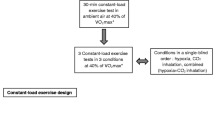Abstract
To clarify whether or not systolic and diastolic function of the human left ventricle (LV) were decreased during acute hypoxia, at rest and with exercise, 14 healthy male volunteers [age 25.9 (SD 3.0) years, height 182.9 (SD 7.1) cm, body mass 75.9 (SD 6.9)kg] were examined using M-mode and 2D-mode echocardiography to determine the systolic LV function as well as Doppler-echocardiography for the assessment of diastolic LV function on 2 separate test days. In random order, the subjects breathed either air on 1 day (N) or a gas mixture with reduced oxygen content on the other (H; oxygen fraction in inspired gas 0.14). Measurements on either day were made at rest, several times during incremental cycle exercise in a supine position (6-min increments of 50 W, maximal load 150 W) and in 6th min of recovery. Corresponding measurements during N and H were compared statistically. Arterial O2 tension (P aO2) was normal on N-day. All subjects showed a marked acute hypoxia at rest [P aO2, 54.5 (SD 4.6) mmHg], during exercise and recovery on H-day. The latter was associated with tachycardia compared to N-day. All echocardiographic measurements at rest were within the limits of normal values on both test days. Ejection time, end-systolic and end-diastolic left ventricular dimensions as well as the thickness of left posterior wall and of interventricular septum showed no statistically significant influence of H either at rest or during exercise. Stroke volume and cardiac output were always higher on H-day, which could be attributed to a slight reduction in end-systolic volume with unaffected end-diastolic volume as well as to increased heart rates. Among the indices of systolic LV function the fractions of thickening in the left ventricular posterior wall and interventricular septum showed no differences between H and N at rest or during exercise. However, fibre shortening, ejection fraction and mean circumferential fibre shortening were increased on H-day on all occasions. The mitral-valve-Doppler ratio, the index of diastolic LV function, was decreased with H at rest, showed a more pronounced reduction during exercise and was still lower in 6th min of recovery compared to N-day. It was concluded that with acute hypoxia of the severity applied in this study left ventricular systolic function in our healthy subjects showed a pronounced improvement and left ventricular diastolic function was reduced, both at rest and with exercise.
Similar content being viewed by others
References
Agusti AGN, Barbéra JA, Roca A, Wagner PD, Guitart R, Rodriguez-Roisin R (1990) Hypoxic pulmonary vasoconstriction and gas exchange during exercise in chronic obstructive pulmonary disease. Chest 97:268–275
Alexander JK, Hartley H, Modelski M, Grover RF (1967) Reduction of stroke volume during exercise in man following ascent to 3 100 m altitude. J Appl Physiol 23:849–858
Asmussen E, Nielsen M (1955) The cardiac output in rest and work at low and high oxygen pressures. Acta Med Scand 35:73–83
Balasubramanian V, Mathew OP, Tiwari SC, Behl A, Sharma SC, Hoon RS (1978) Alterations in left ventricular function in normal man on exposure to high altitude (3658 m). Br Heart J 40:276–285
Balke B (1964) Cardiac performance in relation to altitude. Am J Cardiol 14:796–810
Fowles RE, Hultgren HN (1983) Left ventricular function at high altitude examined by systolic time intervals and M-mode echocardiography. Am J Cardiol 52:862–866
Grover RF, Lufschanowski R, Alexander JK (1976) Alterations in the coronary circulation of man following ascent to 3100m altitude. J Appl Physiol 41:832–838
Grover RF, Johnson RL Jr, McCullough RG, Campbell WB, Reynolds RC (1988) Pulmonary hypertension and pulmonary vascular reactivity in beagles at high altitude. J Appl Physiol 65:2632–2640
Henry WL (1982) Evaluation of ventricular function using two dimensional echocardiography. Am J Cardiol 49:1319–1323
Hoon RS, Balasubramanian V, Mathew OP, Tiwari SC, Sharma SC, Chadha KS (1977) Effect of high-altitude exposure for 10 days on stroke volume and cardiac output. Am J Physiol 42:722–727
Hultgren HN, Miller H (1967) Human heart weight at altitude. Circulation 35:207–218
Jackson F (1968) The heart at high altitude. Br Heart J 30: 291–294
Luft UC (1964) Laboratory facilities for adaptation research: low pressure. In: Dill DB (ed) Handbook of physiology. Sect 4-Adaptation to the environment. American Physiological Society, Washington, pp 329–341
Maggiorini M, Bühler B, Walter M, Oelz O (1990) Prevalence of acute mountain sickness in the Swiss Alps. Br Med J 301:853–855
Rokey R, Kuo LC, Zoghbi WA, Limacher MC, Quinones MA (1985) Determination of parameters of left ventricular diastolic filling with pulsed Doppler echocardiography: comparison with cineangiography. Circulation 71:543–550
Roskamm H, Samek L, Weidemann H, Reindell H (1968) Leistung und Höhe. Knoll, Ludwigshafen am Rhein, pp 23–28, 30–31, 51–55
Saksena J, Manchanda SC, Roy SB (1980) Mechanism of reduced exercise capacity at high altitude: the role of left ventricular dysfunciton (abstract). Clin Res 28:208 A
Stenberg J, Ekblom B, Messin R (1966) Hemodynamic response to work at simulated altitude. J Appl Physiol 21:1589–1594
Teichholz LE, Keulen T, Herman MV, Gorlin R (1976) Problems in echocardiographic volume determinations: echocardiographic — angiocardiographic correlations in the presence or absence of asynergy. Am J Cardiol 37:7–18
Tucker CE, James WE Berry MA Johnstone CJ Grover RF (1976) Depressed myocardial function in the goat at high altitude. J Appl Physiol 41:356–361
Vogel JA, Harris GW (1967) Cardiopulmonary responses of resting man during early exposure to high altitude. J Appl Physiol 22:1124–1128
Zwehl WP, Gueret P, Meerbaum S, Holt D, Corday E (1981) Quantitative two dimensional echocardiography in normal subjects. Am J Cardiol 47:866–873
Author information
Authors and Affiliations
Rights and permissions
About this article
Cite this article
Kullmer, T., Kneissl, G., Katova, T. et al. Experimental acute hypoxia in healthy subjects: evaluation of systolic and diastolic function of the left ventricle at rest and during exercise using echocardiography. Eur J Appl Physiol 70, 169–174 (1995). https://doi.org/10.1007/BF00361545
Accepted:
Issue Date:
DOI: https://doi.org/10.1007/BF00361545




